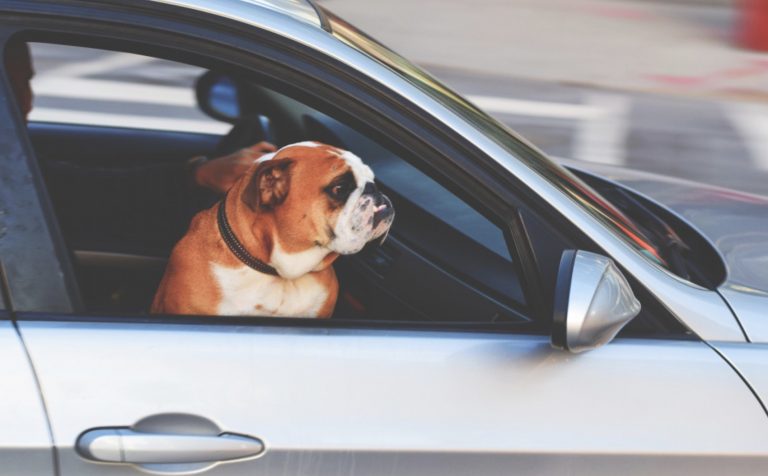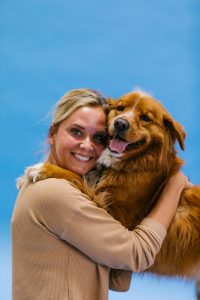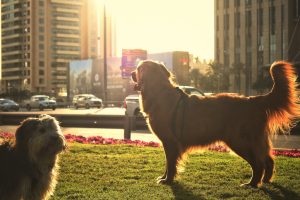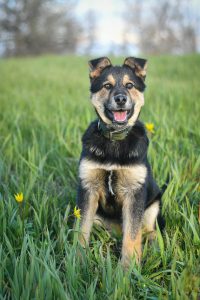Many dogs can display unwanted behavior when they anticipate a car ride. When they anticipate riding in the car, dogs can get anxious, nervous, and refuse to come to you. They might not respond to any commands. And that is because they do not want to travel in the car.
Remember, some dogs bark at cars, and that might make the association that cars are not safe. And this is where you come. It is your responsibility as a dog owner to make sure your dog understands a car is a safe place.
Here is your step-by-step guide on how to make the car a safe place to be.
Step 1 – Safety First
Before you even start thinking about how your dog can travel in the car, make sure you take care of safety measures. The Highway Code stipulates that dogs are suitably retrained. So, before traveling, you have to teach your dog to feel relaxed in a seat-belt harness, pet carrier, dog cage, or in the boot behind a dog guard.
All of the dog traveling tools have to be securely fitted and positioned so that your dog cannot interfere with the driver. Or, hang out of the windows.
Yes, it looks cute when you see dogs hanging out of windows, but it is not a safe thing to do.
Now, speaking about safety measures, never leave your dog alone in the car and keep it cool as possible while traveling.
Step 2 – Make the car a safe place
One of the big mistakes owners make is they rush things. You have to understand many dogs are anxious around cars. They will not get in the car easily.
So, what can you do? You have to teach your puppy that the car is a safe and good place to be. Start by using your dog’s treats and reward your puppy for being calm whenever you are near the car. Yes, near and around the car, not in the car.
This will make your dog feel safer and it will reinforce sitting calmly and being ready for you to open the door.
Step 3 – Getting in and out of the car
Here comes the hard part. Now, some dogs love traveling. They will be excited and jump right into the car and out of it when you arrive at the destination.
But some dogs are not that excited. In any case, your dog should not jump in and out excited. It is better to tell your dog to sit in front of the car, wait patiently for you to open the door, and then reward them with treats as they sit.
The goal here is to teach your dog to sit and patiently wait for the car to arrive and you to open the door. In a way, you are teaching your dog to behave like a President.
If you repeat this exercise, your dog will automatically sit and wait patiently for you to guide it safely inside and under your control.
Step 4 – Spend time in the care
This is another mistake dog owners and pet parents make with an anxious dog around the car. The dog goes in, and you instantly start driving.
Instead, spend some time with your puppy as it is inside the car. Talk to him, give him treats, and reinforce calm behavior. Don’t just start the car and go.
Step 5 – Gradually introduce travel
When you introduce traveling in the car, do it carefully and gradually. Some dogs do not like being in a confined space while the vehicle is moving. It is an unusual feeling for them.
Think about this for a second. In your dog’s mind, all sorts of movement and activities are happening outside, and they can neither get involved nor get away from it. It is a frustrating feeling.
Your puppy needs to get used to the sound and movement of the car slowly. It is a lot for their sense. So, give your dog tasty treats when the vehicle starts and starts to move. This way, your puppy will associate the changes with good things happening.
In the beginning, start with slow and gentle journeys. You should start with familiar journeys to people your puppy already knows or to places it loves. For example, if you usually walk to the park, go by car.
Step 6 – Go back a step if you need to
If you notice your dog is showing signs of discomfort and being frightened, do not force them to. It will only make things worse. And your dog will feel more trapped and panic.
Go back a step in the reinforcement process. If you need, go back at the beginning and introduce the car as a safe place to be. No matter what, the goal here is for your puppy to safely and calmly travel in the car.
Bonus Tip – Call a friend for help
In some cases, having a friend, family member, or anybody your dog knows and is comfortable around can help. Call that person and have him accompany your puppy in the beginning. This way, your dog has someone to be beside him while you are driving. It is a much better option than to let your dog loose and have him sit in your crouch while you are driving, right?
Understanding the root of the behavior
The first step to solving any problem behavior is to understand the root of the problem. Why does your dog hate traveling in the car? Does he have a negative association?
Road trips can be traumatic for canine animals, and most of them can be traced to puppyhood. And if your dog hates car rides and he is miserable, he is likely suffering from motion sickness or anxiety.
Puppies and young dogs are at higher risk of motion sickness. Why? Because the part of their ear that manages balance is not fully developed. For adult dogs, the anxiety of the ride is mostly the reason for the problem.
You also have to understand that not all dogs love car rides. They do not like being in a crate (if they travel in one) or they associate car rides with going to some unpleasant place (like the vet for example).
Signs of travel anxiety in dogs
You can easily notice if your dog is comfortable during a car ride or not. The motion sickness symptoms are well recognizable and noticeable. Here are some of the common symptoms:
- Listlessness
- Yawning
- Whining
- Panting
- Lip-licking
- Drooling more than usual
- Uneasiness
- Unusual stillness
- Vomiting
Panting is one of the most common signs. And it is a coping mechanism for discomfort ranging from carsickness to pain to overheating. Panting and lip-licking are prominent signs your dog feels nauseated.
How to keep your dog calm during the ride
Keeping your dog calm during a car ride is one of the essential parts of making your dog love car rides. They need to make the association with something positive and good. As we talked about earlier, the first step is to make your dog comfortable getting into the car.
But now, you also have to keep your pet calm during motion. You can try to distract him with a toy or reserve some special toy for car rides. This way, your puppy can make the association with a positive thing (toy) with something he doesn’t like, car rides.
Some owners try to make their dogs tired before a trip. You can play a game before going on a car ride. But that is a double-edged sword. While tired dogs might be sleepy, tired dogs also drink loads of water. And all that riding with a belly full of water can make the ride even more uncomfortable.
As a last resort, you can turn to products that help with dog anxiety. For example, a calming dog pheromone spray. You can apply it to a car seat cover, bandana around his neck, or on a blanket. This will help put your puppy at ease.






